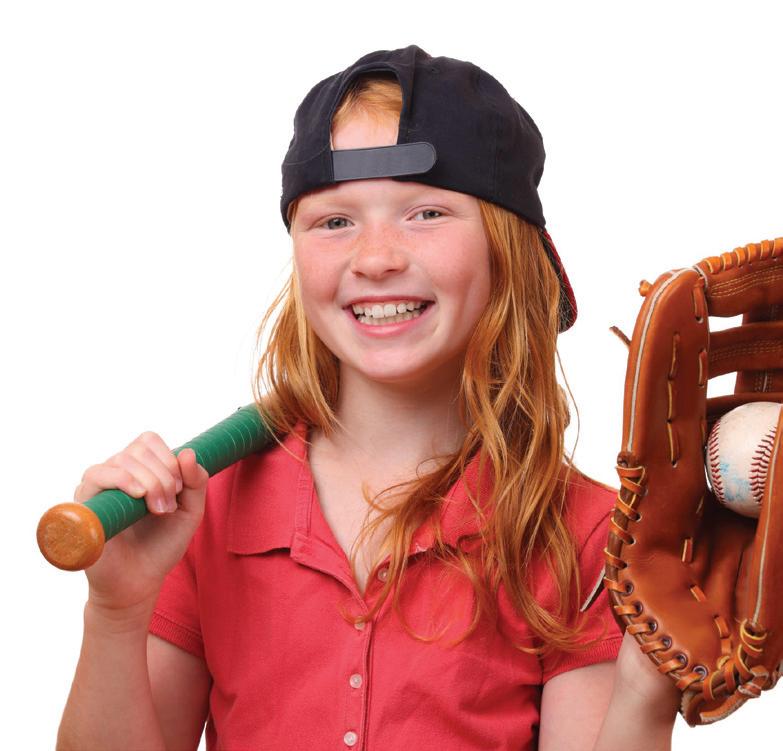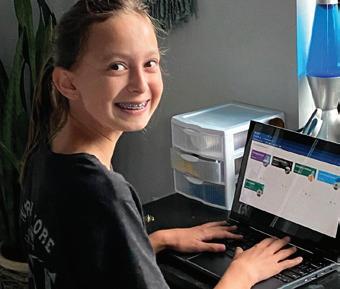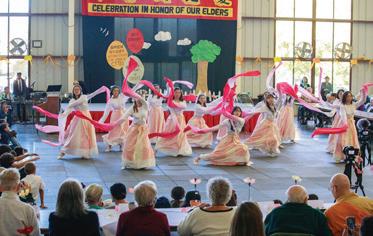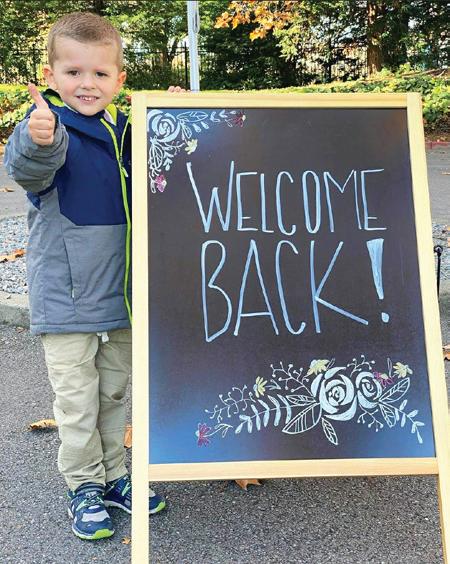
33 minute read
Bits and Pieces
For the Birds
With their eye-catching colors and melodious songs, birds capture the attention of everyone from children to professional ornithologists. For little ones who want to learn more about their feathered friends, there is the Audubon Kids 10-week series of interactive downloadable activities that teach kids about different birds and their habitats. Along with the series, there are also videos that show kids how to draw birds, too. Check out both the series and the videos at audubon.org or tinyurl.com/y8xqlszj. ¶

Play Ball!
In a world of cancellations, it may seem like a small miracle when an activity happens as scheduled. Ta-da! Enter the North Bay Girls Softball League. How will it work in the age of COVID-19? Teams will strictly follow social distancing guidelines. The league is open to ages 5–14, and play will begin in late winter at Northwest Community Park in Santa Rosa. The registration fee is $105–$135. Online registration has closed, so send an email to info@northbaygirlssoftball.org or see northbaygirlssoftball.org to find out more. ¶
Science Spiels
Ever wondered what kind of stone comprises the Sonoma coastline’s majestic cliffs? Find out at the Fascinating Geology of the Sonoma Coast mini-lecture on January 14. The Facebook Live video is part of a series of 15-minute talks presented every Thursday at 2:30 p.m. on the Sonoma County Parks’ Facebook page. Additional talks include Winter Spawning Grounds (January 7); Out of Town Guests: Winter Birds (January 21); and Historic Flooding of the Russian River (January 28). Find out more at parks.sonomacounty.ca.gov and facebook.com/sonomacounty regionalparks/?ref=page_internal. ¶

Nurture the Nurturers
Mothering is a 24/7 job. And mothering during a pandemic brings extra stress. Spiritual life coach Melissa Grace and sound healer Rebecca Webb aim to give moms a break at their online Women’s Self Care Retreat: Nourish Yourself in the New Year. The virtual circle of women will explore dream interpretation, intuition, oracle cards, and sound healing at this two-hour event on January 30, 11 a.m.–1 p.m. PST. Admission is $45. Register at thenightisjung.com/events. Grace and Webb, who each have more than 20 years of experience in the healing arts, maintain private practices in Sonoma County and online. Find out more about Grace at thenightisjung.com and Webb at soundhealsyou.com. ¶

Get Up & Dance
Kids’ rambunctious energy and parents’ need to focus may be at odds during sheltering-in-place. And GoNoodle may have a cure, with its music-and-movement videos that help kids get out their yahoos and get some exercise. Check out the “Cookie Boogie,” starring animated gingerbread dancing to a rap, and “Freeze,” featuring some tween/teen boys twirling and gliding to pop grooves. Find these and many other videos at grownups.gonoodle.com/ goodenergy_familyfun. ¶

Home Is Where the Heart Is
The 2017 Tubbs Fire left behind many stories of devastation. But one of the tales has a silver lining involving the creation of a children’s book. When Carrie Barnes’ family lost their Fountaingrove home in the historic Santa Rosa conflagration, the experience deeply traumatized 7-year-old Brett. Barnes looked around for a children’s book to help her son process his grief, but couldn’t find anything that really fit the bill, so she wrote one herself: Home: A Story of Resilience and Healing (Roundtree Press, 2020). Illustrated by Lyn Meredith, the picture book delivers a simple message: Home is more a matter of who loves you than where you live. Find it on amazon.com. ¶

Mom’s How to Work and Teach at Home Homeroom

By Kerrie McLoughlin
Overwhelming, stressful, and challenging are just a few of the words that can describe working from home while homeschooling. Not only can you survive this unprecedented time, but also you can join the ranks of those who are thriving! Here’s how.
1. Go easy on yourself. No comparing. This includes getting rid of any Mom Guilt about your kids being on screens too much. Sarah Lyons, a writer-mom of six, says, “I think the most helpful thing I’ve learned is that your best is enough. It’s okay if you have to let some things go (housework), and it’s okay if you are working at your own pace. Just doing your best and being aware of what your kids can handle is more important. Don’t compare yourself to others, just do what works for your family.”
2. Carve out your workspace.
I’ve always preferred to work at the dining room table so I can see what’s going on at all times. When it’s mealtime, it’s easy to move my laptop over to a small nearby bookshelf, where I keep anything I need for work and homeschooling. However, there are times when I need a place to focus for a while, and that’s when I move my little operation down to the storage room, where there’s a Formica table, chair, plenty of light, and quiet. Maybe you even have a real, separate office in your home, and in that case, fantastic!
3. Create and post a routine.
While schedules are rigid and only induce more stress, a routine lets everyone know what’s coming next,
so arguments and feet-dragging diminish. My family sleeps late, which means I work in the mornings. Then I put work away to focus on homeschooling until 3 p.m. so my kids know I am entirely available to them. They know when TV time starts at night, what their chores are, and when I’m available for requests. You might work best at night, on weekends, or maybe you work well in 30-minute increments every day, task-switching between homeschooling and work. But…
4. Routines will get disrupted.
Some days homeschooling will be thrown off course. You may have to work overtime, or your child may get sick and your job will have to be put on hold. But it all evens out in the end. You are not going to be caught up on the latest season of anything; you might not have much time to read; and your social media perusing might be non-existent, except for during school breaks.
Just know that there’s going to be a lot of juggling, pivoting, and communicating. 5. Everyone pitches in. Slap up a rough draft of a chore chart as fast as you can, then tweak it as the whining (from kids and spouse!) begins. This way, everyone sees what needs to be done on what days. This takes decision-making out of your court as you simply point to the chart.
6. Solve the daily dinner
dilemma. Creating an easy, rotating meal plan will be the best thing you ever did. Take full advantage of the slow cooker, grocery delivery, and leftover and delivery nights. If you have older kids, now is the time to teach them how to toss together a casserole and pop it in
sonoma
LOCAL for 30 years

the oven while you finish up that last bit of work. Prep meals on weekends and always remember that, if you made dinner, you don’t have to clean it up. While your family tidies up the kitchen, you can get back to your job,
A routine lets everyone know what’s coming next, so arguments and feet-dragging diminish.
help the kids with their homework, or heck, even take a well-deserved shower! Pam Barnhill, of the Homeschool Solutions podcast, has a course called Put Your Meal Plan on Autopilot that’s worth checking out. See plus.pambarnhill.com. 7. Practice saying no. You are at home, so there will be people who expect you to accept them as a drop-in visitor, answer every text in a timely manner, and sign up for all the church and sports volunteer positions. Make your routine clear to anyone who should know, then sit back and say no as often as you need to so you can maintain your sanity, marriage, and family time. Don’t forget to take to heart what June from the blog This Simple Balance says: “Give yourself so much grace to try different things until you find the right balance and routines that work for your unique family.” ¶
Kerrie McLoughlin (TheKerrieShow. com) has been working from home for 19 years and homeschooling for 14 years.

Elevating Excellence for All Enroll Online (TK–8) Academic Excellence Enrichment & More Successful Distance Learning & Homeschool programs sebastopolschools.org (707) 829-4570
#1 local resource for local families
magazine • web • email

Park Side School (K–4) Brook Haven School (5–8)

Brainy Apps Tech Help for Remote Learning

By Tanni Haas
As kids continue to learn remotely from home, they may find it difficult to study on their own, away from their regular teachers and classmates. Luckily, many great study apps are available. Here’s a list of some of the very best ones. They’re all completely free, so download an app—or three!
Classify It! Apple App Store; ages 9–15. When it comes to learning biology, kids need to master the ability to categorize organisms. Developed by the American Association for the Advancement of Science, Classify It! teaches kids how to sort and group animals based on shared characteristics, such as whether they’re amphibians, birds, fish, mammals, or reptiles. Kids can choose to get hints to help them along.
Cyberchase Shape
Quest Apple App Store & Google Play; ages 6–9. Inspired by Cyberchase, the Emmy Award–winning math series on PBS Kids, this app teaches kids basic geometry, including the names of different shapes, spatial properties, and problem-solving.
Flashcards with Cram
Apple App Store & Google Play; ages 6–18. When your kids sit down to study, flashcards are very useful tools. Flashcards with Cram gives them access to more than 80 million flashcards on all the major academic subjects. They can also create their own flashcards using text and images, and share them with classmates. They can go through entire sets of flashcards, hide the ones they’ve already mastered, or have the flashcards read out loud to them.
This app teaches kids basic geometry.
Khan Academy Kids
Apple App Store & Google Play; ages 2–7. Developed in collaboration with experts at the Stanford University Graduate School of Education, Khan Academy Kids is a comprehensive study aid for young kids. It covers math, reading, and writing as well as more general critical-thinking and problem-solving skills. It has lots of informative lessons, books, games, songs, and videos, as well as activities and exercises such as coloring, drawing, and storytelling. You can even monitor how well your kids are doing. LitCharts Apple App Store & Google Play; ages 6–18. The modern-day, app version of CliffNotes is called LitCharts. The app has more than 1,000 guides to the books that are most commonly taught in schools across the country. The guides summarize major plotlines and offer detailed analyses of literary themes and symbols. If your kids need to write papers on specific books, they can search for quotes by theme, chapter, and even individual character and incorporate them into their papers.
My Study Life Apple App Store & Google Play; ages 6–18. If you want your kids to do well on their school assignments, it’s not enough that they know how to do them. They also need to submit their work on time! First task: Download My Study Life. This easy-to-use app lets them keep track of all their assignments, which will help them effectively manage their time. They can also use the app to set reminders for themselves, and get alerts before any particular project is due. Photomath Apple App Store & Google Play; ages 12–18. Photomath is a great math study tool. All kids need to do is to take a picture of a math problem with their phones, and the app will show step-by-step instructions on how to solve it. It has a built-in calculator and can even understand hand-written math problems. Obviously, the kids should try to solve the problems themselves first and then check their answers against the app.
Read with Phonzy
Apple App Store & Google Play; ages 3–5. This app is a great reading tool for the youngest kids in the house. Kids read out loud five simple sentences, which are accompanied by images to help them better understand what the sentences are about. Built-in voice recognition software gives kids feedback on whether or not they correctly pronounced the sentences. If they need extra help, they can tap a Help button to hear the narrator read the sentences out loud.
Snap&Read
Universal Apple App Store; ages 6–18. While the kids are studying at home, there’ll be times when they’re assigned readings that are hard for them to understand. To help them, download Snap&Read Universal. The app can read difficult texts out loud; kids can take notes as they’re listening. They can also ask the app to edit complex texts so the sentence structure and vocabulary are simpler. ¶
Tanni Haas, PhD, is a college communications professor.


Healdsburg Healdsburg School K–8 $15,100 33H Healdsburg Ave. Healdsburg 433-4847 • thehealdsburgschool.org
Rio Lindo Adventist Academy 9–12 $13,356–$24,849 3200 Rio Lindo Ave., Healdsburg 431-5100 • riolindo.org
Saint John the Baptist TK–8 Catholic School Petaluma $7,550–$9,650 217 Fitch St., Healdsburg 433-2758 • sjshbg.org
Harvest Christian School TK–8 $3,800–$8,750 3700 Lakeville Hwy., Petaluma 763-2954 • harvestpetaluma.org
Saint Vincent de Paul K–8 Elementary School $8,380–$9,080 246 Howard St., Petaluma 762-6426 • svelem.org
Saint Vincent de Paul 9–12 High School $17,151 849 Keokuk St., Petaluma 763-1032 • svhs-pet.org
Spring Hill Montessori Rohnert Park 18 mos.–8 $9,410–$18,693 825 Middlefield Dr., Petaluma 763-9222 • springhillmontessori.org
Cross & Crown Lutheran PK–6 Call for rates Church & School 5475 Snyder Ln., Rohnert Park 795-7863 • crossandcrownschoolrp.org

Discover Classical Education in a Christian Environment

HarvestPetaluma.org




• TK-6th Grade On Campus & In-Person Learning • Excellent Distance Learning Program Option (TK-8th) • Safe, Challenging, & Fun Learning Environment!
CONTACT US FOR A TOUR Now accepting applications for 2021/2022 info@HarvestPetaluma.org 707-763-2954

School GradeS TuiTion conTacT info
Santa Rosa
Brush Creek Montessori PK–6 $11,600–$12,441 1569 Brush Creek Rd., Santa Rosa 539-7980 • bcmontessori.org
Cardinal Newman High School 9–12 Call for rates 50 Ursuline Rd., Santa Rosa 546-6470 • cardinalnewman.org
Quest Forward Academy 9–12 $16,950 1500 Farmers Ln., Santa Rosa 733-6452 • ngl.academy
Redwood Adventist Academy K–8 $5,848–$6,996 385 Mark West Springs Rd., Santa Rosa 545-1697 • weloveredwood.com
Saint Eugene’s Cathedral School PK–8 $7,030 300 Farmers Ln., Santa Rosa 545-7252 • steugenesch.org
Saint Rose Catholic School Sonoma Academy TK–8
9–12 $8,425
$46,620 4300 Old Redwood Hwy., Santa Rosa 545-0379 • strosecatholicschool.org 2500 Farmers Ln., Santa Rosa 545-1770 • sonomaacademy.org
Sonoma Country Day School TK–8
$26,950–$29,350 4400 Day School Pl., Santa Rosa 284-3200 • scds.org Summerfield Waldorf PK–12 $6,500–$22,700 655 Willowside Rd., Santa Rosa School & Farm 575-7194 • summerfieldwaldorf.org
Grounded in Christ. Ready for the World.

NOW ENROLLING
TK-12th | MUSIC | SMALL CLASSES We exist, in partnership with families, • Band, Choir, Art to provide a nurturing and challenging • 3rd-6th grade STEM educational experience in a Christ- Robotics Program centered community, where students • Free math tutoring are renewed in the image of their • Opportunities for Creator and are equipped to live out student leadership their God-given purpose for His glory and outreach and the good of others. • Contact us for a tour (707) 539-1486 | 4585 Badger Rd., Santa Rosa | VictoryCA.org


Victory Christian School Sebastopol K–12 $7,000–$10,000 4585 Badger Rd., Santa Rosa 539-1486 • victoryca.org
Pleasant Hill Christian School Sonoma K–6
Presentation School K–8 $6,060
$16,450
Saint Francis Solano K–8 Catholic School $8,664–$9,168
SoloQuest School & Learning Center Windsor 6–12 $10,000
Windsor Christian Academy NAPA COUNTY PK–8 $5,050–$8,150
Justin-Siena High School 9–12 $21,000 1782 Pleasant Hill Rd., Sebastopol 823-5868 • phcs.org
20872 Broadway, Sonoma 935-0122. presentationschool.com 342 W. Napa St., Sonoma 996-4994 • saintfrancissolano.org 414 W. Napa St., Sonoma 939-1133 • soloquest.com
10285 Starr Rd., Windsor 838-3757 • windsorchristianacademy.org
4026 Maher St., Napa 255-0950 • justin-siena.org
Why is your smart child struggling in school?
SoloQuest Learning Center • Determine the cause • One-to-one cognitive skills • Find a solution training works! • Stop the struggle and tears • For ALL ages • Ongoing programs — open enrollment START NOW!
414 W Napa Street, Suite D, Sonoma 707-939-1133 • www.soloquest.com


SonoMa counTY
2021 Featured Private SchoolS
Healdsburg Rio Lindo Adventist Academy.
$13,770–$25,650. This school’s goal is to maximize every student’s potential & instill a sense of independence through its whole-person education. Classes in performing arts, fine arts, auto technology & STEM feature hands-on learning & prepare students for college & life. Grades 9–12. Avg. class size: 12. Enrollment Current/ Max: 130/190. Offers: multi-child/family discount, cafeteria/lunch program, transportation/busing. Casual dress code. Enrollment open for day & boarding school. 3200 Rio Lindo Ave., Healdsburg. 431-5100. riolindo.org.
Petaluma
Harvest Christian School. $3,800–$8,750. Call to learn more about Classical Christian Education. Tours available. Grades TK–8. Avg. class size: 12–16. Enrollment Current/Max: 120/250. Offers: multi-child/family discount & financial aid. Distance learning available. Uniforms required. Class size limited due to COVID restrictions. 3700 Lakeville Hwy., Petaluma. 763-2954. harvestpetaluma.org.
Santa Rosa Summerfield Waldorf School & Farm.
$6,500–$22,700. Waldorf, college-prep, arts & academics. Grades PK–12. Avg. class size: 12–28. Offers: Extended Care, multi-child/family discount, hot lunch program, summer programs. 655 Willowside Rd., Santa Rosa. 575-7194. summerfieldwaldorf.org. Victory Christian Academy. $7,000–$10,000. “Grounded in Christ. Ready for the World.” Band, choir, art. Grades 3–6: STEM Robotics Program. Distance learning available. Contact school for a tour. Grades TK–12. Avg. class size: 15. Enrollment Current/Max: 110/200. Tuition assistance available. Uniforms not required. 4585 Badger Rd., Santa Rosa. 539-1486. victoryca.org.
Sonoma
Presentation School. $16,450. “Working together to love, learn & lead.” Grades K–8. Avg. class size: 20. Enrollment Current/Max: 180/200. Offers: Extended Care & extra-curricular programming, hot lunch program & summer programs. Financial aid available. Uniforms required. 20872 Broadway, Sonoma. 935-0122. presentationschool.com.
SoloQuest School & Learning Center.
$10,000. “All students learn successfully with time & support.” Grades 6–12. Student/teacher ratio: 1:1. Offers: summer programs. 414 W. Napa St., Sonoma. 939-1133. soloquest.com.
Keep Kids Creative Local Arts Education in the Time of COVID

Family Life: What does Art and Soul School of Creative and Performing Arts offer?
Lauren Kushins, co-owner:
We teach art, music, and dance to students as young as 18 months all the way through adults. FL: What brought you to this work? What was your motivation? LK: In the beginning, I was inspired by a Viennese artist named Friedensreich Hundterwasser. He had an art house in Vienna, Austria… and when I was in college I set out to create a healing arts center inspired by it. So that was my focus a long, long time ago. I have been teaching my whole life. My parents are educators. My husband’s parents are educators. (My husband, Benjie, is co-owner of Art & Soul.) Benjie and I have backgrounds in education. I also have a background in social work, which was the basis of my approach. Along the way, I decided I wanted to go into education—and I call education, prevention. If kids have the tools of art—music, art, or dance, any kind of art form—when they hit something hard in life, they can use [those tools] to help them. FL: How has your approach been received?
LK: We have had so many success stories in the 18 years we have been in business. Parents will tell us, “Our kid had been having a hard time, and now all they want to do is practice guitar; all they want to do is draw; all they want to do is dance.” There are so many stories of parents telling us things like that. And that is really our goal, for kids to grow, not go to Juilliard (though we have some talented artists in our bunch). FL: What would you say is the key to your business? LK: Our teachers. They really create fabulous relationships with our students. And those relationships are the heart of who we are. We had a studio in Santa Rosa and in Windsor, but due to COVID, we lost our Santa Rosa school. We decided to let go of it
instead of losing any of our teachers. We were able to keep all of them. FL: Besides the loss of the Santa Rosa school, what other ways has COVID affected your business? LK: We lost all of our dance students at first. Our dance enrollment went down to zero at one point. We are now up to 50 percent enrollment in our dance program. We got students back one at a time; it was hard work. We are back in-person with dance, but we are outside, on our patio. With our art, we are pretty much back to 50 percent enrollment. We were doing some of our classes inside, but with the new shelter-in-place order, all of our art and music classes went back onto Zoom. And we have moved our winter camp outside, too.
FL: So what is the protocol for the in-person dance classes? LK: We have an outdoor check-in, where hand sanitizer is available. Everybody has their temperature checked when they come in. The dancers each have a 10’ x 10’ square that they dance in. When they are in their square, they can take off their mask. When they leave their square to go back to their parents, they have to put their masks back on. And teachers never take off their masks.

FL: How are you producing dance performances? LK: The performances are all virtual, though we record individual performances in-person. We have a huge green screen outside where we record everyone’s performances one at a time. When it’s done, it looks like a group is performing. It’s a lot of coordination. We do something similar for virtual music recitals.
FL: When county restrictions lighten up, how will procedures change at the school?
LK: When the county allows us to hold in-person classes again, everything will be COVID-safe. We are super creative. Music lessons will be held in a huge dance room, where we will hang shower curtains to serve as dividers. When students do a voice lesson, there will be shower curtains hanging between student and teacher. For in-person art classes, there will be plexiglass dividers set up at students’ desks. ¶
Art and Soul School of Creative & Performing Arts is located at 9064 Brooks Road South in Windsor. For more information, visit artandsoulmusicstudios.com.




Prepare for power outages with a Generac home standby generator


REQUEST A FREE QUOTE! 844-209-8952 FREE
7-Year Extended Warranty* A $695 Value!


O er valid December 15, 2020 - March 1, 2021

Special Financing Available Subject to Credit Approval *To qualify, consumers must request a quote, purchase, install and activate the generator with a participating dealer. Call for a full list of terms and conditions.
Friendships Flourish Online 11 Programs That Encourage Kids to Socialize By Kimberly Blaker
For children, social interaction during childhood is more than just fun; it’s a vital part of their development. Engaging in social situations teaches kids cooperation, collaboration, compromise, problem-solving, teamwork, and so much more.

Yet, not all kids have access to sufficient in-person socialization opportunities, especially during the pandemic. Fortunately, kids can connect via online clubs or activities like these:
Activity Hero is hosting a site where various groups and instructors can list activities for kids of all ages. There’s a section with live online classes, after-school programs, and even holiday camps. Options include Legos, science, cooking, art, music, coding, and more.
Child & Adolescent Anxiety Practice’s Virtual
After-School Clubs are particularly beneficial to kids struggling with social isolation and related anxiety. Dr. Shelley Avny, a clinical psychologist who specializes in child and adolescent anxiety, leads the clubs, which emphasize social interaction and collaboration in a structured environment. Six-week sessions feature one 45-minute class per week and serve two age groups: 10–13-year-olds and 14–17-year-olds. Interests covered include cooking, arts and crafts, video games, sports, and more. Clubba, for ages 6–12, offers an online club series with small (up to 5 students), interactive classes
taught by college-student club counselors. Icebreakers and other activities support peer interaction and developing friendships. Connected Camps offers online programs and camps for kids who want to learn about digital entertainment, such as coding, Minecraft, esports, digital arts, and game design. Connected Camps has small group classes that offer kids opportunities to interact with others and collaborate on projects or games in a fun environment. It also hosts a free moderated Kid Club Minecraft server for kids ages 8–13. Counselors mentor kids using a research-supported approach, and enforce a code of conduct.
Destination Science offers summer camps and after-school clubs for ages 5–11. Participants receive science kits with the materials needed to participate in live instructor-led sessions.
FunClubs offers live, online, instructor-led 45-minute classes for kids in grades K–8. Larger classes are broken down into groups of 6–8 students, allowing kids more time to interact with the teacher and each other. Subjects include drama, piano, guitar, Spanish, filmmaking, coding, cooking, and more. iD Tech hosts technology classes and camps for kids, ages 7–19, who want to learn or develop their technology skills. It offers weeklong online sessions of no more than five students, combining instruction time with opportunities for classmates to collaborate and socialize.
Lavner Education offers technology camps with a STEM focus for kids in grades 1–9. A selection of more than 40 classes feature 4–8 students per instructor and provide opportunities for hands-on, experiential learning, collaboration with classmates, social interaction, and opportunities to progress through skill levels.
Open Tent Academy caters more directly to homeschool students but offers some “after-school” classes for kids. These classes focus more on learning material than socializing, yet provide opportunities for student discussion and interaction.
Outschool is a small-group learning platform for ages 3–18. It offers more than 100,000 classes, so it caters to practically any interest your child might have. Kids learn from teacher experts while interacting with classmates who share the same interests.
Playcrafter Kids Club is a 6-week program for younger students, ages 3–7, and features two hour-long classes per week. Children work with four teachers trained in the arts and participate in drama, music, yoga, and dance. Kids are split up into small groups, and during parts of the lesson they can unmute and interact with their classmates. ¶
Kimberly Blaker is a freelance family writer and also founder and director of KB Creative Digital Services, an Internet marketing agency: kbcreativedigital.com.
McDonald Ranch Distance Learning & Enrichment Program


“Our children have never been happier”

• Supervised by a credentialed teacher & 3 adult assistants. • Mornings are spent doing Zoom meetings and other academic work assigned by students’ schools. • Afternoons include archery, horse-riding lessons, interaction with farm animals, ceramics, crafts & camp games. • Safe social setting provides a lifetime of memories.
Programs held at Sky Tree Ranch in Santa Rosa www.mcdonaldranch.org • 707 583-6711
Lose the Don’t Fall for Old Diet Tricks Quarantine 15

By Sandra Gordon
Little white lies aren’t so bad when, say, your mother-in-law gifts you with a not-so-great sweater. With your diet, however, honesty really is the best policy. That’s because the small food fibs you tell yourself, as in “I need to eat this macaroni and cheese to get through the pandemic,” can sabotage your health goals. Do any of these other common diet self-deceptions sound familiar?
You tell yourself: “I can just eye-ball my portion sizes to gauge calories.”
Reality check: “Most of us aren’t good at perceiving how much we eat,” says dietetics professor Sandria Godwin, RD. In fact, in Godwin’s research, subjects who judged portion sizes just by looking at them underestimated amounts by an average of 23 percent. Diet fix: If you’re serious about controlling portions, don’t guesstimate. Weigh meat with a food scale (aim for 3 ounces per meal) and measure everything else with teaspoons, tablespoons, and measuring cups for at least a week and track it all in a food diary. After that, you can just eyeball amounts. But go back to weighing and measuring every few months to tweak your portion-size perception. “Portions tend to get a little bigger and bigger over time,” Godwin says. To outwit your appetite, use a 9- to 10-inch dinner plate so portions don’t look too small and tempt you
Don’t drink your calories.
to go back for seconds. Keep eating out to a minimum or just eat less of what you’re given because no matter how much you think you ate, it’s probably more than that.
You tell yourself: “My body needs a detox every once in a while.”
Reality check: Forget the seasonal juice fast. You actually need to detox every day. The good news? You don’t need to do anything special beyond eating a healthy diet. “Your body is well-endowed with the apparatus to take care of the job,” says David L. Katz, MD, co-author of How to Eat (Houghton, Mifflin, Harcourt, 2020). Your liver, spleen, kidneys, and gastro-intestinal tract constantly filter “toxins” out of your system—breakdown metabolic gunk such as fat molecules, spent red blood cells, urea (a byproduct of protein metabolism), and other waste products. Diet fix: To keep these systems in good working order so you can continuously detox more efficiently, load up on unprocessed foods, such
as fruits and veggies. Their high water and fiber content speeds waste through your GI tract. Get plenty of fluids, too, (anything watery counts) so your kidneys can flush water-soluble by-products through your system. Regular exercise also helps keep your blood circulating through your arteries and delivers a robust supply of blood to your spleen, liver,
and kidneys. Meanwhile, avoid “toxins” by not smoking, shunning secondhand smoke, and steering clear of foods high in refined sugar and artery-clogging saturated fat and trans fat.
You tell yourself: “Calories don’t count if I drink them.”
Reality check: Liquid calories count just as much, if not more, than solid-food calories do. That’s because they’re not as satiating. “When people drink water, milk, fruit juice, Pepsi, Red Bull, a smoothie, or whatever beverage, they don’t compensate for those calories by reducing their food intake,” says nutrition professor Barry M. Popkin, PhD. In other words, liquid calories can slide in under your brain’s calorie-counting radar.
Diet fix: Aside from nonfat milk to help reduce the risk of osteoporosis, don’t drink your calories. Stick to water or noncaloric beverages like unsweetened iced tea between meals. And realize that when you do drink something caloric, including alcohol, it won’t fill you up but it will fill you out unless you exercise more or make a conscious effort to account for the calories. For example, say to yourself, “this is lunch,” while sipping a smoothie.
You tell yourself: “I’ll eat less if I skip breakfast.”
Reality check: A major study that analyzed the breakfast patterns of 12,316 men and women for five years found that breakfast skippers were more likely to have a higher
Load up on unprocessed foods, such as fruits and veggies.
body mass index than breakfast eaters. The breakfast eaters also set a healthier tone for the rest of the day. They consumed fewer foods high in fat and sugar. Diet fix: The study found you’ll only get that a.m. advantage if you start the day off with foods low in energy density, such as unsweetened hot or cold cereal, or whole-grain bread, fresh fruit, and nonfat milk. Otherwise, breakfast can backfire. Your overall daily calorie tally will be higher if you feast on the likes of pastries and sausage/egg/bacon sandwiches, says Ashima Kant, PhD, the study’s lead researcher, and this can lead to weight gain. ¶
Sandra Gordon is an award-winning freelance writer who delivers expert advice and the latest developments in health, nutrition, parenting, and consumer issues.
Never Underestimate the Power of the Purse

Moms typically control 80% or more of their household budgets
They’re looking right here, to find you. Call now. Don’t miss another month.
IN PRINT • ONLINE • EVENTS • CONTESTS
586-9562 MendoLakeFamilyLife.com
Overcome Trauma The Somatic Experiencing Hack

By Evan DeMarco
Even the happiest person has experienced trauma. The type and extent may vary, but everyone has had some type of trauma. If you work through your issues and resolve the trauma, you can go on to lead a happy life—but many people carry unresolved trauma with them for years, if not their whole lives.
Medical practitioners have spent decades researching methods for treating post-traumatic stress disorder (PTSD) symptoms, in addition to wide-ranging physical and mental trauma-related conditions. One of these researchers is trauma therapist Peter A. Levine, PhD, developer of the Somatic Experiencing® method for addressing and healing trauma and other stress disorders.
Fight, Flight, and Freeze
There are three animal responses to imminent threats: fight, flight, and freeze. They’re designed to help you protect yourself from or survive the encounter with the threat. In a split second, your brain assesses a situation and decides if it’s better to fight it off, run, or play dead. When you’re in danger, your body automatically activates your sympathetic nervous system (SNS). This triggers a primal response in the brain to either fight, flight, or freeze. Your adrenal glands simultaneously release the adrenaline you need to maximize your strength—whether you plan to fight back against the threat or turn tail to escape from it. This whole process is completely automatic and something that’s been ingrained in humans and animals since the beginning of time. It’s why we’ve survived!
How Does Trauma Affect Us?
Trauma develops when the freeze response is disrupted—that moment before your body can fight back or flee. Your body creates energy to fight or flee, and then the freeze
phase of the cycle must run its course to release that momentum. If the energy isn’t channeled, the result is trauma. Think of it like shaking up a soft drink, then putting it back in the fridge without opening it to release the pressure. The Somatic Experiencing (SE) framework states that trauma occurs when the unresolved freeze response causes an imbalance in your nervous system—not during the event itself. SE helps patients complete the freeze response. That is, once a patient has worked through any lingering freeze responses, the body can release the energy the SNS created during the traumatic event.
To overcome trauma with SE methods, you work to access your “body memory” of the event, instead of the event itself. That means you don’t need to discuss the traumatic event to move past it, which is often helpful for people who become anxious addressing or reliving a traumatic event.
How SE Can Help You Overcome Trauma
A certified SE practitioner (SEP) will focus on reconnecting you with the physical sensations of the traumatic experience in order to become aware of them. Then you can use SE tools to release the trauma.
Resourcing: SE treatment begins with resourcing. Patients create internal resources to make them feel safe. They discuss cherished memories, loved ones, favorite pastimes, and other comforting touch-points to figure out what is a resource for them.
Titration: After patients create the resources to comfort themselves, they can address the trauma in a productive way. The therapist works with the client to revisit the physical sensations of the trauma—not the event itself. The SEP monitors the patient’s responses, noting any changes in breathing, crying, shift in voice tone, shaking, tensed muscles, shivering and/or clenched fists. This trains the body to gradually release the trauma. Pendulation: This stage is also known as “looping.” Pendulation helps your body regain homeostasis and balance. The purpose is to train the body to naturally move back and forth between states of alert and calm, without triggering the fight-orflight response. This creates a more resilient nervous system, so the patient can handle future trauma.
Why SE Works
While other psychological approaches prioritize memories and thoughts, SE addresses the manifestations of trauma. It’s designed to reveal the habitual behaviors that trigger PTSD and other trauma-related symptoms. The patient can then work to mitigate triggering behaviors. Traumatic experiences can take over your life, leaving many people feeling trapped in their own minds and bodies. If that sounds like you, find a trained SEP to help you address and process your physical trauma manifestations. Everyone deserves to be free from trauma. To find an SEP in Sonoma, Lake, or Mendocino Counties, go to traumahealing.org and click on “Find a Practitioner” in the upper right corner of the homepage. ¶
Evan DeMarco is a leading sports medicine scientist and nutrition expert, published author, public speaker, and frequent guest on television, radio, and digital platforms. He is the co-founder of Complete Human (completehuman.com). This new multi-media platform takes a deep dive into the areas of mind, body, soul, and planet while exploring what makes us who we are and what will make us better.
ENJOYING OUR MAGAZINE?
sonoma
FREE!
September 2020
Autism Aid Routines work
Virtual Nana
Kids connect
Find a Tutor
Tips for success
Moms-to-Be
Local COVID-19 advice





